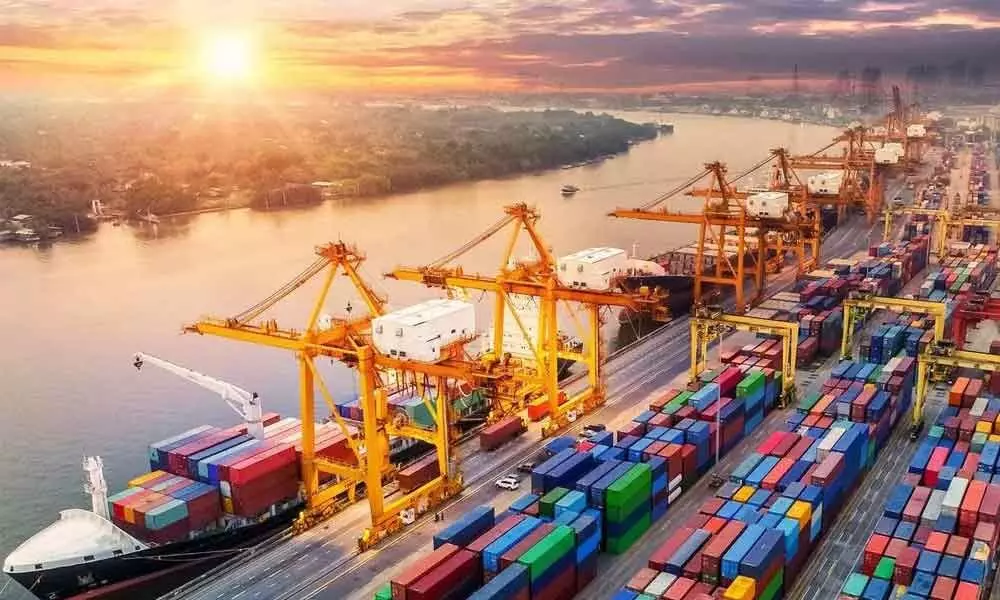Despite record exports, India needs to strengthen policy push
It seems Ukraine conflict has opened up prospects for higher exports in some key areas but, in long term, efforts to sustain export effort should be continued without any sense of complacency
image for illustrative purpose

Last week's Mann ki Baat radio address by Prime Minister Narendra Modi included a call to convert the local into the global. The comment was made in the context of India achieving a record $400 billion worth of exports in the 2021-22 fiscal. The immediate enthusiasm is justifiable on reaching the milestone as it has come when the economy is recovering in fits and starts from the slough of the pandemic. Exports have risen not just in comparison to the previous fiscal when the economy contracted by 6.6 per cent, but also compared to the pre-pandemic period. The value of exports was $313 billion in 2019-20 and $291 billion in 2020-21. Besides, a major positive of the higher export growth is that the bulk of the increase has been in manufactured products where there is value addition, rather than in raw materials and intermediates.
At the same time, it must be recognised that India is still lagging behind in exports when considered as a percentage of GDP. About a decade ago, this was as high as 18 per cent, but has now dipped to about 11 per cent. The country thus has a long way to go before it can truly be considered among the world's top trading nations. With the latest achievements, the economy may break into the list of top 15 global exporters. But it should have reached there much earlier given the size of its economy.
The Prime Minister was correct, however, when he noted that the export landmark reflects the growing strength of the country's supply chains. This is among the factors behind the surge in exports over the past year. Domestic infrastructure has undoubtedly improved considerably over the past few years and this, in turn, has enhanced the competitiveness of Indian exports. In the past, logistics delays have been a key factor hampering speedy delivery of goods from the country's air and seaports.
Another reason for the spike in exports has been pent up global demand following the pandemic especially in western countries. This came in tandem with the efforts by many countries to diversify sources of supply for many products instead of relying largely on China. Logistics issues including ports congestion and container shortages also hampered supplies from that country, enabling Indian exporters to fill the gaps in many sectors.
Policy initiatives taken over the past few years have equally been a factor in pushing export growth. These have been aimed at providing ease of business for the exporting community. Export incentives have been refashioned to make them compatible with WTO guidelines. The launch of the production –linked incentive (PLI) schemes in the electronics sector also led to the creation of clusters of production units that became big exporters. In addition, the push for agricultural exports resulted in a considerable increase in this area lately. Both rice and marine exports have risen sharply but horticultural products are also a growth area.
As for the composition of exports, a positive aspect is that value added goods comprise the biggest share. Engineering goods, for instance, comprise the largest segment and have risen by as much as 50 per cent. Chemicals and pharmaceuticals as well as readymade garments have also show sizable expansion. Petroleum products which comprise value added products from the country's oil refineries are among the top export commodities. Gems and jewellery exports which had fallen sharply during the pandemic have shown a revival too.
Whether the spurt in exports will continue in the medium and long term will depend largely on whether these export initiatives will be deepened and intensified. Along with that is the need to tie up more trade pacts with major trading partners. One of the stumbling blocks in the way of improving export competitiveness, has been the failure to enter into regional trade agreements that have given an edge to other countries. India's decision to keep aloof from the Regional Comprehensive Economic Partnership (RECP) was considered a mistake by many analysts but it was probably wise to keep away from a grouping dominated largely by China. The fear was that the rules of origin were not stringent enough to prevent a flood of imports sourced from China but coming from southeast Asian countries.
The situation is now being rectified with several free trade pacts currently in the process of negotiations. The India-UAE free trade agreement is the first to have been concluded, a landmark since it is over a decade since the last FTA was entered into with a major trading partner. Others on the anvil include the India-UK FTA where both sides are keen to have an early resolution. Agreements with Canada, Australia and the six member Gulf Cooperation Council are also expected to be finalized during the course of this year. The long-pending FTA with the European Union has been revived but this may take longer, given the rigidity over issues like spirits, automobiles and intellectual property rights.
In the short run, it seems the Ukraine conflict has opened up prospects for higher exports in some key areas where supplies are facing disruption. Wheat exports from Russia, for instance, seem have got disrailed due to the crisis and India is making plans to fill the gap in availability. The Commerce Ministry is reported to be in talks with several countries including Egypt to tie up shipments. The amount could be as high as 12 million tonnes, compared to the previous export level of about 8.5 million tonnes by this country.

